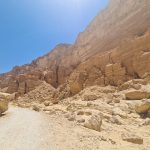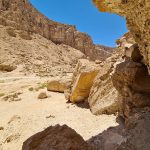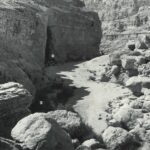BIʾR AL-ʿAYN
| Arabic | بئر العين |
| English | Bir al-Ayn |
| French | Bir el-Aïn |
| DEChriM ID | 43 |
| Trismegistos GeoID | 2845 |
| Pleiades ID | - | PAThs ID | - |
| Ancient name | - |
| Modern name | Biʾr al-ʿAyn |
| Latitude | 26.633228 |
| Longitude | 31.823252 |
| Date from | -1400 |
| Date to | 800 |
| Typology | Rock shelter |
| Dating criteria | - |
| Description | The site is situated directly north of Aḫmīm in a wādī named Wādī Biʾr al-ʿAyn, though Kuhlmann notes that it is known also as ‘Wādī al-Salāmūnī’ and ‘Wādī Šayḫūn’ (Kuhlmann 1983: 4). The area is described as being a narrow valley, encumbered with fallen rocks, and bordered by high, steep mountains (Pococke 1743: 78; Bouriant 1889: 145). As well as including a biʾr dedicated to Šayḫ Šayḫūn, the valley contains a number of Christian features which have never seen a great deal of study, only ever having been mentioned briefly in passing (Maspero 1887: 220). As a result of this brevity, details of these features are not wholly clear. It is well-documented that there a number of caves in the area, though no specific, or even approximate, numbers are recorded. Pococke describes “several grottos and little cottages, probably built by the Christians”, which were understood to have been occupied by anchorites or by regular Christians during times of persecution (Pococke 1743: 78; Maspero 1887: 215). There is one specific cave/tomb that was mentioned by everyone who recorded their visit to the area, which is situated some 30-40 meters above the ground, only intermittently accessible via a precarious path along the cliff-face (Saint-Génis 1817: 60; Maspero 1887: 215-216; Bouriant 1889: 146). It is unclear if this is simply a cave or a built structure, however; Pococke describes it as “a building halfway up the mountain, which might be some hermit’s cell”, while Lucas and others refer to a cave (Pococke 1743: 78; Lucas 1714: 362-363; Maspero 1887: 216). Maspero notes that this cave/tomb is situated to the left of the ruins of a dilapidated church, or ‘convent’, which seems to be known by the name ‘Ma’doud’ (or ‘Dermadoud’) (Saint-Génis 1817: 60; Pococke 1743: 78). This structure has some chambers built into the rock, the largest of which was presumed to have been a refectory, while a church was built in front of the rock on the slope of the mountain, constructed in bricks (Lucas 1714: 362-363; Pococke 1743: 78; Maspero 1887: 215). Pococke mentions that the walls of the chapel had originally been covered in graffiti in red and black ink, though this had been completely removed by the time Maspero visited (Pococke, 1743: 78; Maspero 1887: 215). Within the vicinity of this built monastic structure – Maspero mentions that it is c. 20 minutes away from the ruins – is the main feature of the site that has piqued the most academic interest: a large rock covered in graffiti, which, for some reason, was not included in Pococke’s description (Saint-Génis 1817: 60; Bouriant 1889: 146; Maspero 1880: 220). Many of the texts on this specific rock, the earliest of which is from the 18th Dynasty, refer to hunting, while the graffiti of interest here are Christian in nature (Maspero 1887: 218). Some of these Christian texts are written in Akhmimic Coptic and attest to a fourth-century occupation of the area (Maspero 1887: 219 n. 1; Bernard 1977: 1-43, the Christian texts in Greek are nos. 1b, 11b, 12, 13 and 14). Maspero noted the presence of an additional rock, a few meters behind this main one, which is also host to graffiti, though they are less clear, with additional graffiti identified by Kuhlmann on another rock (Maspero 1887: 219; Kuhlmann 1983: 9). Kuhlmann rejects the idea that the area was home to a large monastic community, stating that many of the caves are too small and inaccessible to have been occupied, and that there are too few remnants of built structures (Kuhlmann 1983: 9). He states, instead, that it must have been a modest, and relatively small community who were capable of sustaining themselves with the minute horticultural production. |
| Archaeological research | No excavation work has ever been conducted at the site, and there have only ever been a limited number of individuals who recorded their visit. The first of these seems to have been P. Lucas, followed by R. Pococke, both of whom only made brief comments (Lucas 1714: 362-363; Pococke 1743: 78). A. Saint-Génis, one of Napoleon’s savants, also visited the site and included a brief description of it in the Description de l’Égypte (Saint-Génis 1817: 60). G. Maspero and U. Bouriant then visited at the end of the 19th century, during which time they copied much of the graffiti from the main rock, which were subsequently published by Bouriant (Maspero 1887: 213-219; Bouriant 1889: 145-149). The most recent account is that of K. P. Kuhlmann, who visited the site as part of the research conducted on the wider area of Aḫmīm in the early 1980s. Kuhlmann was the first to identify two additional Greek graffiti on another rock, the publication of which he entrusted to G. Wagner (Wagner 1983: 349-354). Kuhlmann mentions that a built church structure, likely that mentioned above, was examined by P. Grossmann with the intention to publish the results and associated plan (Kuhlmann 1983: p. 9 n. 35). This never seems to have come to fruition, however, with the site only ever having been mentioned briefly by Grossmann, specifically in stating that the monastic occupation of the site dates from the seventh century (Grossmann 2002: 270). Prospection work was conducted by members of DEChriM on 22.06.2022 in an attempt to identify the presumably monastic features of the area but this was unfortunately not achieved. The expedition did, however, lead to the identification of as-of-yet unidentified Christian graffiti on an additional rock. |
• Bernard, A. 1977. Pan du désert. Leiden: Brill.
• Bouriant, U. 1889. “Notes de voyage.” Recueil de travaux 11: 145-149.
• Kuhlmann, K. P. 1983. Materialien zur Archäologie und Geschichte des Raumes von Achmim, 8 sq. and pl. 7, 10b, 15. Mainz: Philipp von Zabern.
• Lucas, P. 1714. Voyage du sieur Paul Lucas, fait par ordre du Roy dans la Grèce, l’Asie Mineure, la Macédoine et l’Afrique, vol. 2, 362-363. Paris: Nicolas Simart.
• Maspero, G. 1887. “Sur les fouilles et travaux en Égypte pendant l’hiver de 1885-1886.” Bulletin de l’Institut égyptien 1886: 213-219.
• Pococke, R. 1743. A Description of the East and Some other Countries I. London: W. Bowyer.
• Saint-Génis, A. 1817. “Notice sur les restes de l’ancienne ville Chemmis ou Panopolis aujourd’hui Akhmym et sur les environs.” In Description de l’Égypte ou Recueil des observations et des recherches qui ont été faites en Égypte pendant l’expédition de l’armée française, edited by Edme-François Jomard et al., vol. 4, 60. Paris: Imprimerie de C. L. F. Panckoucke.
• Wagner, G. 1983. “Deux prières chrétiennes.” Bulletin de l’Institut français d’archéologie orientale 83: 349-354.


 Json data
Json data









